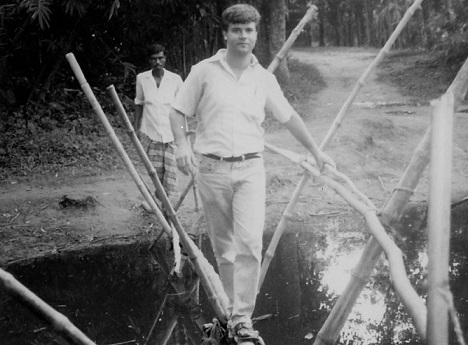
Reflections in and about Williamson. Photo by Anna Reich
What is Williamson, West Virginia?
I don’t believe it is possible to define a town, much less a town I met only 36 hours ago.
I arrived in Charleston’s Yeager Airport shortly after noon on Sunday. The hotel offered a complimentary shuttle from the airport with a most amicable driver. While chatting about various things West Virginia, such as my childhood obsession with the Sacramento Kings and specifically West Virginia’s own Jason Williams, the driver asked the purpose of my visit. I explained the Fulbright – Amizade collaboration with Sustainable Williamson, the idea of global service learning, and some additional background on the Fulbright Program. He asked me to clarify where I would be going.
“Williamson?” he said, “that town is so poor they have a layaway program at the dollar store.”
I hoped he was not able to see my puzzled expression in the rearview mirror. It was unclear to me if he was speaking from fact or out of sarcasm and I had no idea how to respond.
“That place is a step back in time,” he continued.
After muttering an interjection and giving a half-smile, I moved the conversation forward with small talk and eventually we arrived at the hotel. For the rest of the day, I never shook the stark picture he painted with his words. An image of absolute poverty and a community lost. An image that is frequently projected on to communities in Appalachia. But what was the basis for this stereotype? I hoped to find out.
On Monday morning we drove through picturesque Appalachia. The bluish purple cast of the rolling, seemingly infinite, hills and the delicate mist constructed an almost dreamlike landscape. Perhaps this serene stillness is the origin of the preconception that Appalachian towns are sleepy, I pondered. We pulled into what appeared to be a small, but comfortable country town and I assumed we were stopping for food or to refuel. When Nathan Darity, the Amizade Community Engagement Coordinator and the Executive Director of The Global Switchboard, explained we had arrived in Williamson I was very shocked. This could not be the Williamson about which the hotel driver spoke.
Our first destination was the Williamson Health and Wellness Center, where Jenny Hudson (Director of the Mingo Country Diabetes Coalition), Nate Siggers (Amizade’s Appalachia Site Director), Ian Fields (AmeriCorps VISTA Member of Williamson Health and Wellness Center), and Mary Arnot (Health and Wellness Promoter) shared the many initiatives they have begun with the goal to breath life back into central Appalachia. Two of the inspiring programs they have developed in a relatively short amount of time are a community-based and federally qualified health center that serves the residents of Southwestern West Virginia and Southeastern Kentucky regardless of insurance status, and the Mingo County Diabetes Coalition.

Beautiful natural light in the future ballet studio. Photo by Anna Reich
The Coalition works diligently to promote active living and healthy eating throughout the region in a series of ways. The group facilitates regular opportunities for active community engagement including a regional talent show called Coalfield’s Got Talent, which boasts over 40 participants. The Fulbright Amizade group will see a preview later this week. Alexis Batausa, a health and wellness promoter with the Coalition, organizes monthly 5K races in addition to leading two programs, the Lunch Walk/Run and the Take 10 Health Challenge. The Coalition is also spearheading a project to build community gardens near lower income housing to increase access to healthy foods. A factor in the development of these various sustaining projects is their replicability. The Williamson Health and Wellness Center is not intimidated by its own smallness. The Center maintains that their vision is not for Williamson alone, but that other communities in the region have already started adopting their initiatives and they hope to continue to grow.

Framing and un-framing Appalachia. Photo by Anna Reich
Williamson, like any place, has social issues that need addressing. The town is sharply segregated and the population has continued to drop since the steady decline of the coalmining industry. For decades coalmining was a way of life here. Now with the decline of the coal industry and a growing need to diversify economic opportunities, there is inevitable struggle.
I have heard people in Williamson talk about pride. A person can have pride regardless of circumstances. I suspect Williamson will always have pride, but because of the Williamson Health and Wellness Center and their various revitalizing initiatives, I believe Williamson has been offered a beacon of hope and a path forward.
It is not possible to define a place, much less so when one is a visitor. I don’t know what I don’t know. What I do know is that there is not a dollar store in this town and perhaps Williamson, and the Appalachian region as a whole, deserve a second look.


2 Comments
Dear Anna: Greetings. I am a reporter for the newspaper in Charleston, W.Va., doing a story on the Fulbright-Amizade collaboration with Sustain Williamson. Could you give me a call as I am interested in talking with some of you about your experiences. Douglas Imbrogno: 304-348-3017
I grew up in Williamson and I know what your driver meant; every time I say I’m from Williamson somebody makes a joke. It’s hard to have confidence and hope and move ahead with your life when everyone has this attitude about you based on where you come from. When you get outside of West Virginia, the same attitude exists about your state. We need to change our image and our self image.